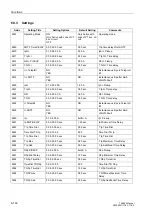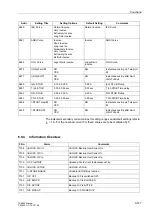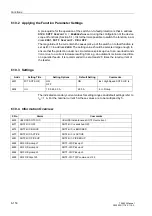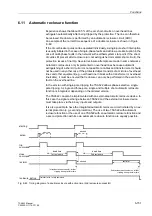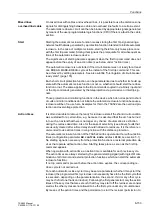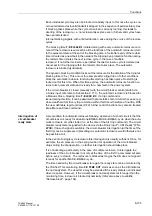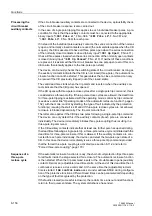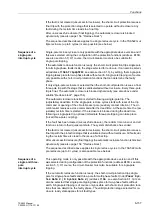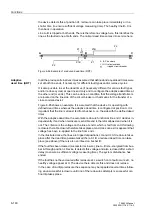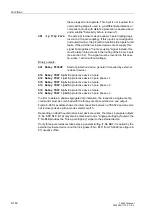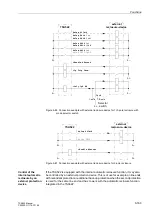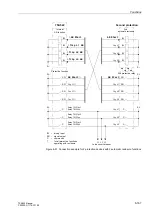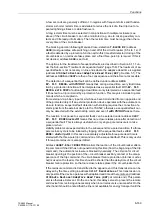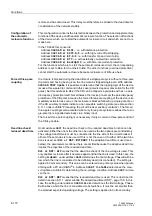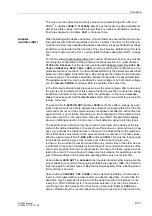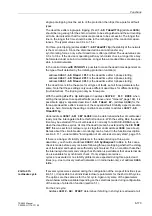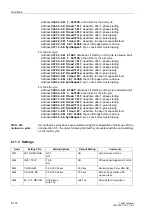
Functions
6-160
7SA522 Manual
C53000-G1176-C119-2
the device detects this at position
III
, reclosure can take place immediately or in a
shorter time (to ensure sufficient voltage measuring time). The healthy line B–C is
then back in operation.
Line A–B is tripped at both ends. There is therefore no voltage here, this identifies the
line as the faulted one at both ends. The normal dead time comes into service here.
Figure 6-84 Example of a reduced dead time (RDT)
Adaptive
dead time (ADT)
In all the previous alternatives it was assumed that defined and equal dead times were
set at both line ends, if necessary for different fault types and/or reclose cycles.
It is also possible to set the dead times (if necessary different for various fault types
and/or reclose cycles) at one line end only and to configure the adaptive dead time at
the other end (or ends). This can be done on condition that the voltage transformers
are located on the line side of the circuit breaker or that means for the transfer of a
close command exist.
Figure 6-85 shows an example. It is assumed that the device
I
is operating with
defined dead times whereas the adaptive dead time is configured at position
II
. It is
important that the line is at least fed from busbar A, i.e. the side with the defined dead
times.
With the adaptive dead time the automatic reclosure function at line end
II
decides in-
dependently if and when reclosure is sensible and is therefor allowed and when it is
not. The criterion is the voltage on the line at end
II
, which is fed from end
I
following
reclosure there. Reclosure therefore takes place at end
II
as soon as it is apparent that
voltage has been re-applied to the line from end
I
.
In the illustrated case, the lines are tripped at positions
I
,
II
and
III
. At
I
reclosure takes
place after the dead time parameterized there. At
III
a reduced dead time can take
place (see above) if there is also an infeed on busbar B.
If the fault has been cleared (successful reclosure), line A– B is re-energised from bus-
bar A through position
I
. Device
II
detects this voltage and also reclosed after a short
delay (to ensure a sufficient voltage measuring time). The system disturbance has
ended.
If the fault has not been cleared after reclosure at
I
, a switch on to fault occurs at
I
, no
healthy voltage appear at
II
. The device there detects this and does not reclose.
In the case of multiple reclosure the sequence may be repeated several times follow-
ing an unsuccessful reclosure until one of the reclosures attempts is successful or a
final trip takes place.
Z1B
Z2
A, B, C busbars
I
,
II
,
III
relay locations
tripped circuit-breaker
Z1
Z1B
Z2
Z1
A
B
C
I
II
III
Summary of Contents for siprotec 7SA522
Page 20: ...7SA522 Manual C53000 G1176 C119 2 ...
Page 64: ...7SA522 Manual C53000 G1176 C119 2 ...
Page 89: ...SIPROTEC 4 Devices 4 25 7SA522 Manual C53000 G1176 C119 2 Figure 4 20 CFC Logic example ...
Page 408: ...7SA522 Manual C53000 G1176 C119 2 ...
Page 456: ...7SA522 Manual C53000 G1176 C119 2 ...
Page 516: ...7SA522 Manual C53000 G1176 C119 2 ...
Page 620: ...Appendix B 48 ...

